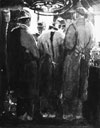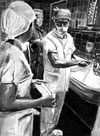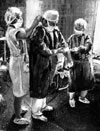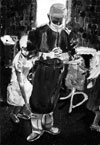The Art of Surgery
Paintings by Joseph R. Wilder, M.D.
(Page 1) |
Page 2 |
(Page 3)
Click on the small painting with each description to see a larger version.
|

|
Five Surgeons �
"Sports records are made to be broken, not treasured," says surgeon
Thomas Starzl. "Similarly, in an active field of the life sciences, including
surgery, almost everything occurring more than five years ago
is dismissed as obsolete. Consequently, there is little sense of history
in medical literature. In his dual roles as a surgeon and artist, Joe
Wilder has turned the tables. Seen through his creative lenses, everyday
scenes in the operating theater and support areas provide a cumulative
profile of surgery that can only be called heroic." (This particular
scene is also reproduced in color on the cover of this issue.)
"Wilder's style, which at first glance suggests hardy realism, has a
certain brooding spontaneity to it," observes art critic Donald Kuspit.
It "conveys the tense inner life of the outwardly calm surgeons, absorbed
in their seemingly ritualistic tasks."
|
|

|
Surgeons as Heroes
Kuspit adds that "Wilder is the surgeon in many of the pictures—
a surgeon triply privileged in that he not only performs an operation
in as careful and caring a way as possible, but is aware of his own state
of mind as he performs it, and can express his state visually. . . . Wilder
has the subtle skills of an impressionist Chardin," the critic continues.
"He is clearly the master of the inanimate thing—showing, in fact,
that it is implicitly alive. . . . These subtly expressive paintings, with
their deceptive straightforwardness, epitomize Wilder's most basic interests
as both a surgeon and an artist."
|
|

|
Preoperative Examination
"The handling changes in the pre- and postoperative works, which
focus on the doctor-patient relationship," explains Kuspit. "It is softer
and more fluid" than in the operating-room paintings, "which for
all their expressionistic force convey a sense of determined solidity.
. . . I think Wilder truly understands what Hippocrates meant when
he wrote, 'Wherever the art of medicine is loved, there is also the
love of humanity,'" Kuspit adds. This statement "is, in effect, the motto
that explains the motivation of his surgeon paintings."
|
|
 |
Scrubbing Hands
The surgeon "must be ever mindful that carelessness can create a
critical infection, undoing a skillful operation," points out Wilder.
Even "before the team scrubs and gowns, the chief surgeon thoroughly
reviews the patient's chart while checking the major pathology and
dozens of recorded tests on the chart to be doubly sure that all is in
readiness for this major assault on the body. The experienced healersurgeon
trusts no one," emphasizes Wilder. "Complications are best
handled when anticipated, rather than encountered."
|
|

|
Gowned and Gloved
"The relationship of the surgeon to the patient is intimate, one on one," says Wilder's fellow surgeon
C. Everett Koop. "The surgeon knows that he is responsible to the patient and also to the family, his colleagues,
the hospital where he works, the profession he represents, the community of the patient, society
in general." And, Koop adds, there is a "spiritual responsibility as well. The patient's soul, this patient's spirit,
inhabits a body which now I am attempting to invade, to improve, and to avoid violating. The intimacy
the surgeon enjoys with a patient," he admits, "has its drawbacks. When I was a young surgeon there
was a time before every operation when I would have to come to grips with that relationship and try to
diffuse my emotional attachment to the patient."
Art critic Kuspit picks up on the same dichotomy when he observes that in this series of paintings, "the
lower part of the surgeons' faces are hidden behind an impressive mask, making them seem remote and inhuman—
scientific and detached. But their haunted eyes betray their intense feelings and profound sympathy
. . . [their] peculiarly vulnerable awareness of the human condition."
|
�
|

|
Contemplation Before Surgery
"My favorite painting of Joe's is Contemplation Before Surgery," says
Koop. "I know the surgeon has just scrubbed his hands and arms to the
elbow and while doing so was subconsciously or consciously going
over the details of the operation. His body and mind are now as prepared
as they will ever be to engage the surgical challenge ahead. He
is also . . . communicating at all times with the other team players, for
their contributions are significant if the surgery is to be successful."
|
�
(Page 1) |
Page 2 |
(Page 3)
Back to Table of Contents
